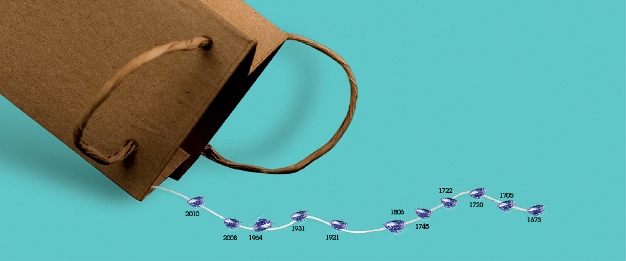From Auction To Outrage: The Tale of the Wittelsbach Blue Diamond
April 28, 10
At auction after auction, one buyer’s name constantly comes up, that of Laurence Graff. The self-made billionaire has bought some of the most sought after gems in the world, at hard to conceive prices. In 2006, he paid a record $3.6 million at Christie's for an 8.2 carat cushion-cut Burmese ruby. Most recently, he bought the Wittelsbach blue diamond, which was offered for sale at Christie’s
The celebrated diamond was expected to achieve a price in the region of $15 million. After just minutes of furious bidding, with Graff pitting himself against Aleks Paul of Essex Global Trading, the stone went for an astonishing $24.3 million, the highest price ever paid for a diamond at auction.
“In the midst of these challenging times, we were thrilled to achieve an historic price for an historic diamond. At $24.3 million, the 35.56 carat Wittelsbach blue
diamond, dating to the 17th Century, has become the most expensive diamond sold at auction, topping the previous record of $16.5 million for a 100 carat diamond in 1995 in Geneva,” said ,” said François Curiel, chairman of Christie's Europe and auctioneer for the sale.
But while he now had possession of the famed diamond, with its multiple royal connections (see below), Graff did what only a man of his standing, and with what many called his “chutzpah” or cheek, could, he re-cut the stone, leading to a furious debate among historians, diamantaires and connoisseurs when he revealed the newly cut stone early this year.
The 17th century gem, which came with a GIA certificate indicating its characteristsics as a fancy deep greyish-blue, VS2 clarity stone, was resized, by no fewer than three cutters, into a trimmer diamond weighing just over 31 carats. While it may have lost some of its weight, the recutting process also removed some of the flaws that had crept in over the three hundred and more years since it was cut. In addition, it took advantage of modern cutting techniques that were not available when the stone was originally fashioned.
But not everyone was happy with Graff’s decision. “That stone has a pedigree that is incomparable,” Daniela Mascetti, a senior global specialist in jewelry at Sotheby’s, told the New York Times. “The provenance of a gem is important in ways that are not true of other things. With the Wittelsbach blue, you knew how it came into existence and in a rather exciting way. You know who has worn it, what kinds of historical events it has gone through and what social upheavals it was present for.”
| |
British newspaper The Telegraph quoted renowned master diamond cutter Gabriel Tolkowsky, as saying that the treatment of the diamond was an omen of the "end of culture."
In addition, reports the world over referred to the unhappiness of the entire German people for what is considered in that country to be the vandalism of a national treasure. “This is barbarism. You cannot begin to describe the damage he has done. The stone may look a bit more lively and sparkling, but its history has been destroyed,” Dieter Hahn, one of
His opinion was echoed by Hans Ottomeyer, director of the
The newspaper also quoted Graff’s reaction to the flood of criticism he faced for having recut the diamond. "The diamond had many imperfections, besides wear marks it was chipped and it had an extra large culet (flat central surface of the diamond)", he said. "I repolished the stone in order to bring out its full potential, bringing to it more life and color but at the same time making sure that its original features were retained."
Rather than selling the stone, which Graff has renamed the Wittelsbach-Graff, immediately, it is being displayed at the Smithsonian Institute in
No doubt the diamond will fetch more than its auction price whenever it is offered for sale. And there will be some who will debatabe if it can even be called the same stone. Profit has triumphed over history, but at the end of the day, even this is just another facet of an incredible stone’s amazing provenance.
History of the Wittelsbach Diamond
1664 King Philip IV of
1673 The jewels were recorded in an inventory of the Austrian Crown Jewels dated 13 March 1673.
1705 Leopold I bequeathed the blue diamond to his third wife, Empress Eleonore Magdalena.
1720 Archduchess Maria Amalia inherited the blue diamond from her grandmother, the Empress Eleonore Magdalena.
1722 The diamond entered the House of Wittelsbach after the marriage of Archduchess Maria Amalia to the Bavarian Crown Prince, Charles Albert. The diamond then became known as ‘Der Blaue Wittelsbacher’.
1745 The Wittelsbach was first mounted within the insignia of the Order of the Golden Fleece. The diamond was handed down through successive Bavarian rulers.
1806 Maximilian IV Joseph von Wittelsbach became the first King of Bavaria and commissioned a royal crown prominently displaying the blue diamond.
1921 After the proclamation of the
1931 Christie’s offered for sale important jewelry from the Bavarian Crown Jewels, which included the Wittelsbach.
1964 The diamond was purchased by a private collector, in whose family it remained until being offered for sale in Christie’s December 2008 sale Jewels: The London Sale.
2008 The diamond was purchased by Laurence Graff for a record-breaking $24.3 million
2010 The recut diamond, renamed the Wittelsbach-Graff diamond, goes on display at the
